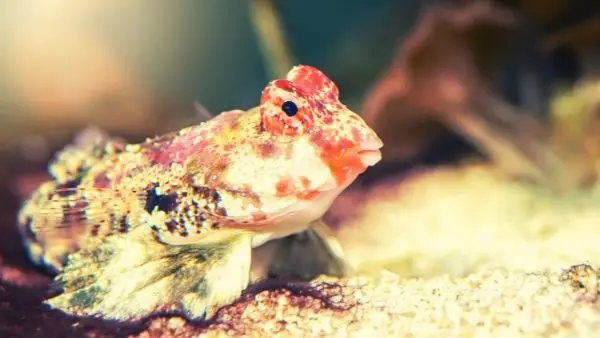Despite being constantly referred to as the Scooter Blenny, the Synchirous Stellatus is actually, in fact, a member of the Dragonet family not the Bleniidae family (despite the name). Other names used for this fish are Red Scooter, Red Dragonet, Scooter Blenny, Starry Blenny, and Starry Dragonet.
These beautiful and vibrant fish originate from the rocky reefs of Japan, off the Southern coast. They are not only aesthetically glorious with their awesome patterns and array of bright colors, but they have big personalities and will provide an abundance of entertainment for all hobbyists.
The Red Scooter Blennies require a pre-established aquarium due to their unique feeding habits - they are not competitive eaters like most other fish. They will typically pick at rock-work for a lot of the day, providing themselves with entertainment and food at the same time. They are typically not distracted from what they are doing even if food is introduced to the tank.

Male or Female Red Scooter Blenny?
Differentiating the males from the females is a surprisingly easy task, as the males have an extremely large exaggerated dorsal fin, and the female's fins are a lot smaller, and far less pronounced. They can be kept either singularly, or in pairs of males and females, even a singular male with a harem of females will be fine.
Red Scooter Blenny Tank Requirements
- The minimum tank size for this fish is 30 Gallons (135 Liters).
- They are peaceful by nature and will not cause any harm to other community members.
- They are not prone to disease.
- They are not beginner compatible, experts and experienced hobbyists should look into acquiring them.
- Their maximum size is around 2.75 inches (7 cm), they are small fish.
- They are well suited to living in reef aquariums.
- They are not compatible with predator tanks, keep them away as they will likely become a tasty snack!
- Their somewhat unique feeding habits require moderate to expert care levels - they do require attention.
- The tank's pH level should be between 8.1 and 8.4.
- The perfect tank temperature should be between 24°C to 28°C (75F to 82.5F).
- They prefer hanging around substrate and rockwork, hiding and burrowing themselves in substrate for protection, so their tank level will be low for them.
- Hiding places are certainly required for this fish.
- The ideal number to a tank can be anywhere between one male or female, or a male/female pair, or even a male with a harem of females.
Feeding Habits and Methods
The Red Scooter Blenny does need specific requirements when it comes to feeding them. They will spend the majority of their day picking away at rocks and the sand bed.
A large population of live copepods is essential for these fish. There are some that will also accept frozen foods, such as mysis and brine shrimp. It is worth seeing if they will take those foods, as feeding Scooter Blennies is very much a trial and error type of process.
They are carnivores, and so a varied, balanced diet consisting of copepods and meaty foods is a must. They are incredibly slow eaters and will certainly not be in any rush to the top of the tank when you begin feeding your community. They need the chance to stumble across the food when they are doing their usual daily activities, so make sure the rest of your tank isn't stealing their food.
Acclimatization
The acclimatization process is very similar to other Blennies. You will place your fish in a bucket and drip acclimate for 1 hour (60 minutes) with a drip rate of 3 per second. This will then bring your fish's water parameters in line with the parameters of your tank.
Once your Red Scooter Blenny has been drip acclimated, you need to catch it with a net and place it gently into your tank. It is crucial when performing this process that you do not put any of the water the fish originally arrived in, into your tank.

It is important to take care after you have added the Scooter Blenny by securely fastening the lid of your tank, and keeping it tightly fitted at all times. These fish have been known for their jumping and will most definitely jump when initially introduced to an aquarium community.
Common Questions
Can I keep a Scooter Blenny with a Mandarin Dragonet?
Yes, we know that you want the coolest aquarium that displays a plethora of incredible and bright colors, with many fish of different shapes, sizes, and patterns, so, adding a Scooter Blenny to a tank with the mesmerizing Mandarin Dragonet would be awesome in theory, but will it work?
The answer is yes! They are from the same family, despite contrasting names, and regardless of this, they will likely get along just fine. The only thing to make sure of is that they are both being fed accordingly, this is because they share very similar eating habits and diets.
Both types of fish are incredibly peaceful, playful, and independent, because they spend all day picking at rock-work and substrate, they will usually be ignored and not bothered by their tank mates.
Final Words
So, in conclusion, they are lovely fish, with so much character and life. Obviously, it helps tremendously with any fish if they are bright in color and unique in pattern, and the Scooter Blennies are that down to a tee!
They are also such great fish to add to communities due to their peaceful nature, they will never cause problems or be a tank bully, all in all, they are fantastic fish to keep if you have the required experience!
